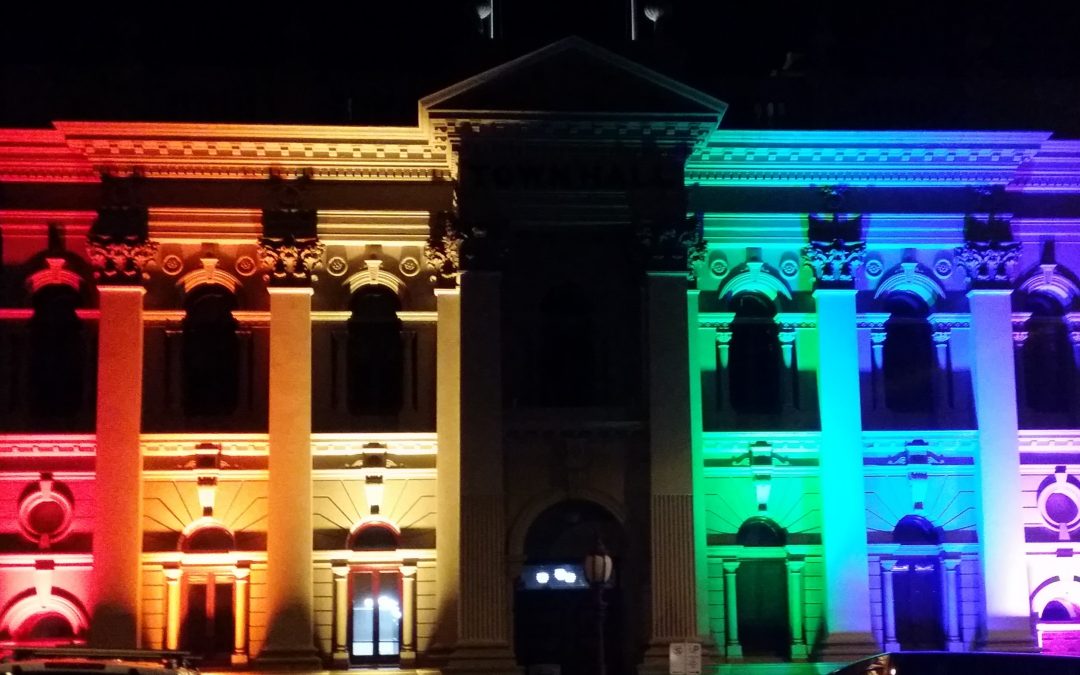Opinions that blind and divide
We do not knowingly, hold the wrong opinion. If anything, instead of questioning our own opinion, we may actually seek to confirm it. It can also be the case, that we will cling tightly to our opinions with little understanding of how others could have an opinion that is different to ours. Unfortunately, our opinions will blind us to the stories of those around us, and will have us play the ‘them and us’ game. The topic of support for the LGBTIQ community, sadly, is one such topic where opinions are fired across political, religious, and personal battlefields, with little attention being given to the collateral damage along the way. Opinions create blindness to the ‘us and us’ stories that surround. Stories where the personal endeavour of authenticity results in highs and lows, regardless of what letter one may identify as.
Three main goals
There are three main goals for this article:
- To the Straight community – Can you be bold and question your own attitude and behaviour toward the LGBTIQ community?
- To the LGBTIQ community – Are you aware of the challenging journey that many straight people take in re-working their thinking in regards to the LGBTIQ community. It can take time, and is often the result of personal encounter, and may come at considerable personal cost, as world views rarely dismantle overnight.
- To start a conversation – I have witnessed too many ‘debates’, which have simply been two opposing sides stating their opinions and positions, with little or no openness to hearing what it is that the other has to say. I have witnessed too many tears shed, when one’s opinion has been held so tightly that, that it has cost another their well-being and mental health, and in some cases, it has been the catalyst for someone taking their own life. The cost of opinion is too great.
Stages of Support.
It is my observation that there are several stages, or levels of support and understanding, that one from the Straight community may move through regarding their opinions of the LGBTIQ community. These stages are not static, nor does any one stage sit in isolation from another, with several influencing factors playing into this. Such as:
- The manner in which supporting or opposing behaviour is expressed.
- How supporting or opposing behaviour is received.
- How much positive or negative effect, supporting or opposing behaviour may have on individuals within the LGBTIQ community.
- How much positive or negative effect supporting or opposing behaviour may have on individuals within the Straight community.
- Aspects of intentional and unintentional long-term outcomes.
- The context one finds themselves in – some communities are safer than others.
- Varying degrees of how behaviour of support or opposition is viewed by others, despite one’s intention.
Eight stages in brief.
- Opposed: Rejects and openly opposes the LGBTIQ community and their supporters.
- Conditional pseudo acceptance: Will say they accept, but will not affirm.
- No longer opposing: Accepts legitimacy of the LGBTIQ community, though is potentially neutral in opinion or silent.
- Invisible Acceptance: Holds a positive personal opinion of the LGBTIQ community, though are not vocal. Will possibly speak of support privately.
- Visible Acceptance: Support is vocal and visible.
- Interactive: Interacts with the LGBTIQ community and is demonstrably safe and supportive; moving into advocacy.
- Advocate: Actively works for culture change through education and activism.
7a. Advocates with the LGBTIQ community:
7b. Advocates for (on behalf of) the LGBTIQ community:
- Fully immersed: Lost touch with the straight community and has taken on the persona of the LGBTIQ community.

As a graph, there are several features (see fig. 1).
- The numbers along the X (horizontal) axis become incrementally closer with a slightly larger gap near the end. This is to demonstrate the potential amount of attitude change required to move from one stage to the next.
e.g: 1 2 3 4 5 6 7 8 - The Y (vertical) axis demonstrates effectiveness, whether it be negative (below the X axis) or strong positive, further up the Y axis.
In what follows, I have used descriptive terms such as ‘strong negative’, ‘zero’ or ‘strong positive’, in an attempt to describe outcomes despite ones’ intention. For example: in stage 2, one may believe they are being positive by saying that they accept an individual who is gay, but as soon as they state that they are non-affirming, their good intention results in a negative, and potentially harmful, effect.
The stages expanded.
- Opposed: Rejects and openly opposes the LGBTIQ community and their supporters.
Strong negative effect for LGBTIQ as intended, though believes this is for positive purpose.
People in this stage actively oppose the LGBTIQ community and their supporters. Many in this group may refer to sacred texts, past social norms or biology i.e.: procreation is absent. This group is often known for the zeal in which they actively and openly oppose. There are also those who oppose and will express their opinion passively e.g: liking and sharing posts on social media.
- Conditional pseudo acceptance: Will say they accept, but will not affirm.
Negative effect though intended to be positive to LGBTIQ.
This is potentially the most dangerous stage due to the genuine intention of good. Phrases such as ‘we accept you, but cannot affirm you’, or ‘love the sinner and hate the sin’, seek to divide the LGBTIQ individual from their sexuality. By denying their sexuality, the individual is sent back to a divided and dissonant life (that they may have experienced prior to coming out), or may prevent them from coming out. This group may also have an agenda for changing the LGBTIQ individual with forms of ex-gay therapies or ministries.
- No longer opposing: Accepts legitimacy of the LGBTIQ community, though is potentially neutral or silent.
Zero effect, though intended to be positive (with potential negative effect).
This individual could be accused of fence sitting, though the amount of attitude change that has taken place should not be underestimated. They may have had a personal encounter that has caused great challenge. This person may fear the reaction of others, were they to express their support. This person needs encouragement from others who have gone before them.
- Invisible Acceptance: Holds a positive personal opinion of LGBTIQ, though are not vocal.
Slight positive effect.
This person has no opposition toward the LGBTIQ community and may acknowledge this in private conversations. However, in a public setting, they may remain neutral or silent and make claims that ‘it’s not their business’; a ‘them and us’ mentality remains.
- Visible Acceptance: Support is vocal and visible.
General positive effect.
Becoming more vocal in their support by adding their voice to the many who already do support. They may sign petitions and attend rallies, though there may still be a ‘them and us’ mentality. They are motivated by ‘the right thing to do’, though they are not involved in the community, but believe they are playing their part.
- Interactive: Interacts with the LGBTIQ community and is demonstrably safe and supportive; moving into some advocacy.
Strong positive effect to individuals.
For this person, there is no ‘them and us’. Sexuality is as important, as it is unimportant in relating to, and identifying with the LGBTIQ community. There is a strong understanding of story, journey and the challenges that are encountered. This person has a foot firmly planted in both the LGBTIQ community and the Straight community and is able to work with individuals in helping to bring about understandings of each. They potentially advocate on a small-scale.
- Advocate: Actively works for culture change through education and activism. Works with both straight and LGBTIQ communities.
- 7a. Advocates with the LGBTIQ community.
Strong positive effect to a broader audience of both straight and LGBTIQ.
This individual works with the LGBTIQ community in the work of advocacy, education and cultural change. They are part of the community and have shared the journey with many, yet are equally connected to the Straight community. They know the stories of individuals and have walked with them through difficulties. Whether it be through programs, or with organisations, institutions or political leaders, the goal is cultural change on a broader scale.
- 7b. Advocates for (on behalf of) the LGBTIQ community.
Strong positive effect to a broader audience with the potential to have a positive and/or negative effect for LGBTIQ.
This individual’s goal is the same as the one mentioned above, ‘cultural change on a broader scale’. However, they potentially maintain a ‘them and us’ mentality, and may be motivated by a desire to help or to combat injustice. However, the crucial element of relationship with individuals within the community may be missing.
- Fully immersed: Lost touch with the straight community and has taken on the persona of the LGBTIQ community.
Potential negative effect though intended to be positive.
This straight individual has lost touch with their straight community. Their persona and identity is connected to the LGBTIQ community and may potentially lack their own sense of identity. This individual may potentially be regarded with suspicion by the very group where they find their belonging.
Having stated all of the above; the use of general terms needs to be acknowledged and no doubt there are examples where what has been suggested may not be the case – thus the invitation for conversation. It also needs to be noted, that what one’s attitude may be, and how it is demonstrated, is done so in the belief that they are right; thus, the challenge. This article is not the result of research, but of observation, many discussions, and the encounter of countless personal stories.
About Gwen
Gwen is a school teacher, counsellor, author and presenter. Gwen’s counselling practice caters particularly for children, adolescents, teachers and parents, as well as generalised counselling. She works with individuals in relation to mental health and wellbeing. Gwen is the author of Bully Resilience: Changing the Game. See www.equipcc.com.au for more information.


Recent Comments